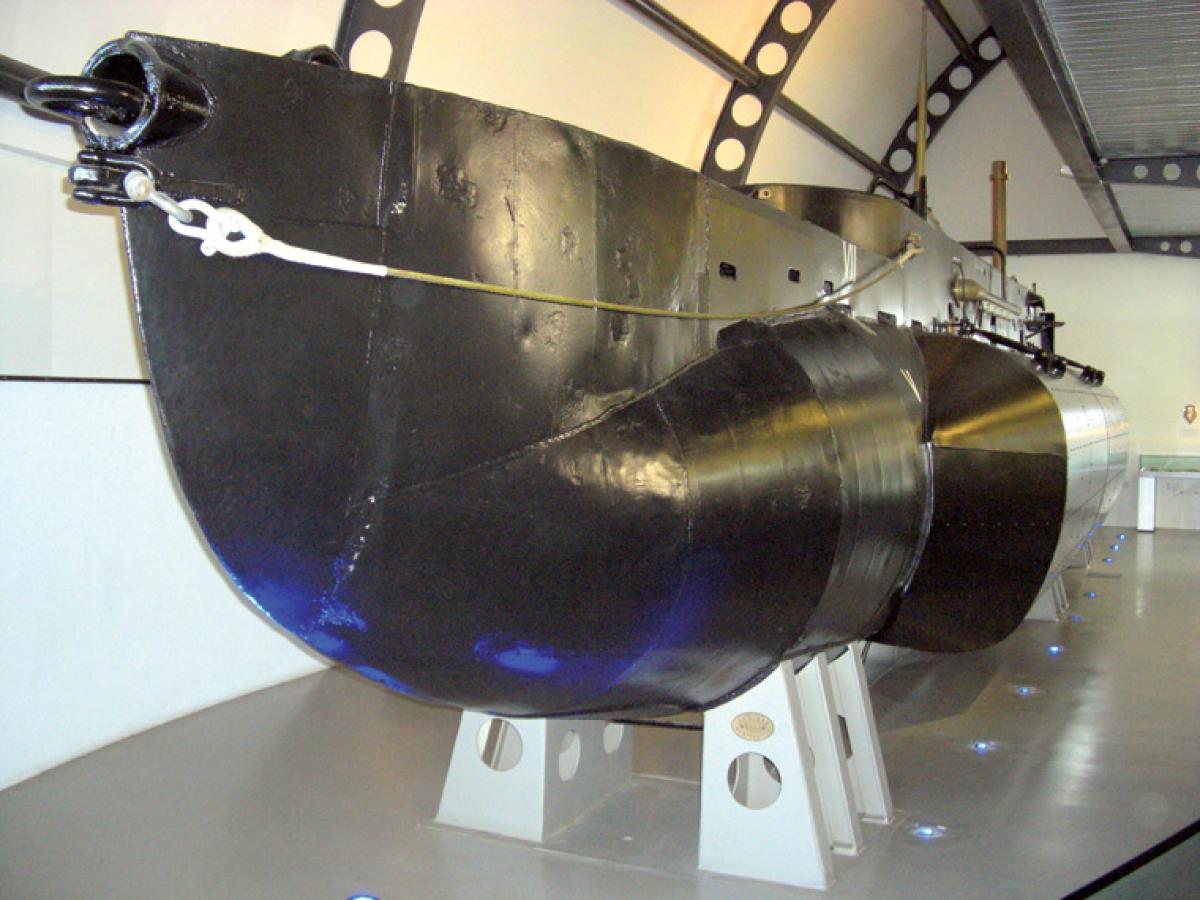Within Gosport’s marina in England lies HMS Alliance—Britain’s only surviving World World II–era submarine. The Alliance is the showpiece of the Royal Navy Submarine Museum, which spotlights several submarines, a variety of sub artifacts, an expansive weapons collection, and model submarines. The museum surveys the fascinating history of naval units that were vital in the World Wars and the Cold War.
The 281-foot Alliance was an Overseas Patrol A-class submarine. In response to the Cold War, the Royal Navy modernized the Alliance for a new Soviet submarine interceptor role. During her refitting, the forward and aft hull section was rebuilt, and the submarine’s sonar updated.
The hull of the Alliance was rusting away at the Submarine Museum until a £7 million restoration program began in earnest in 2011. The exterior of the sub has been fully restored, and was unveiled in July 2013. Holes at the front were filled and the exterior was freshly painted. The entire restoration was completed in March 2014, and the Alliance opened for guided tours.
The Submarine Museum has three buildings that display smaller submarines, their armaments, equipment, and small models. Next to the entrance is the Weapons Gallery, a separate building that houses various submarine armaments. Within the gallery is the middle section of a Polaris nuclear missile. Each of four Royal Navy Resolution-class subs carried up to 16 Polaris missiles. Other submarine weapons housed there are Mk 24 Tigerfish wire-guided homing torpedoes, Mk 8 torpedoes, and long-range land-attack Tomahawk missiles.
The Weapons Gallery also includes a Biber one-man German submarine. This is the most recent submarine addition to the museum, restored by Fleet Support Limited. The maintenance and repair company also tested the Biber with its original electric motor in one of the docks of Portsmouth. The submarines were armed with a couple of short-range torpedoes. The German navy built them to strike at Allied coastal shipping, but the Bibers were somewhat ineffective.
In an adjacent room of the Weapons’ Gallery visitors can also check out some of the weapon control systems once included in nuclear submarines. The rooms include a DCA Tactical Data Handling System fitted to nuclear subs of the 1980s. Submarine Torpedo Directors, which showed the angle at which torpedoes should be fired, also are displayed.
The Holland 1 building features the Royal Navy’s first submarine, which was commissioned in 1901 and became obsolete before World War I. The museum salvaged and restored this diminutive craft, which was put on display in 2001. The Holland 1 is housed in a building specially equipped with a powerful dehumidification system to avoid corrosion on the sub. Visitors can board the Holland 1, but little of her original interior remains intact. The gallery also includes the bulkhead clock removed from the Holland 1.
The John Fieldhouse Building, a zinc and steel structure shaped like a submarine and topped with a conning tower, is the museum’s primary building and features the History Gallery. In this ground-floor gallery a variety of small submarine models are on display such as HMS Dreadnought, the Royal Navy’s first nuclear submarine.
HMS X-24, also known as the Expeditious, can be viewed as well. The World War II midget submarine was rehoused as part of a £3.1 million museum expansion in 2005. The Royal Navy built these X-craft to penetrate Norwegian fjords that sheltered German battleships. X-24 took part in a few operations to penetrate heavily fortified Bergen Harbor, which included Lakesvaag floating dock. On her most famous operation the submarine sunk the floating dock. X-24 still includes much of her interior, displayed from an opening between her engine, cut off at the back, and the rest of the submarine.
HMS Conqueror’s periscope, used during the torpedoing of Argentina’s General Belgrano cruiser, is also included in this part of the museum. The original captain’s cabin of the Conqueror is another of the more notable additions to the museum gallery. Visitors can sit in the cabin and watch an informative video.
On the John Fieldhouse Building’s second floor, the Historic Gallery covers the World Wars, notably details on Royal Navy submarine operations. Among the intriguing items displayed in the gallery are an Iron Cross, a Victoria Cross, HMS E11’s periscope, and a German U-boat badge.
Another second-floor exhibition hall covers the science and design of more modern submarines. It has a small open cinema that plays a video explaining how navies deployed submarines during the Cold War. In another notable exhibition on the second floor, a small room shows the interior furnishings of a submarine.
Outside the museum, between the Weapons Gallery and Holland 1 building, interesting submarine parts are displayed. Along the pathway between the buildings is a 12.3-ton propeller from HMS Repulse and the E17’s sail and conning tower. A JIM atmospheric diving suit also is shown.
Royal Navy Submarine Museum
Haslar Road, Gosport, Hampshire
PO12 2AS, England
Phone: 44 23 9251 0354
www.submarine-museum.co.uk
Take the Gosport ferry from Portsmouth and follow Gosport’s waterfront promenade up to the museum entrance.
Hours:
April–October: Open daily, 1000–1730, with last admission sold at 1630.
November–March: Open Wednesday– Sunday, 1000–1630 with last admission sold at 1530.
Closed Mondays and Tuesdays except on school holidays.
Admission: Adults £14, Seniors £11, Child £10, Family (2 adults and up to 3 children) £38
Visiting a good museum? Why not contribute a report? Contact us at: articlesubmissions@usni.org.



